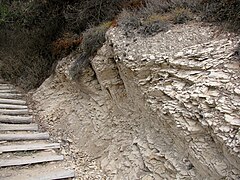| Sisquoc Formation | |
|---|---|
| Stratigraphic range: Lower Pliocene, upper Miocene | |
 Sisquoc Formation at the stairs to More Mesa Beach, Santa Barbara, California | |
| Type | Sedimentary |
| Underlies | Pico Formation, Santa Barbara Formation, others |
| Overlies | Monterey Formation |
| Thickness | Up to 1000 feet in Santa Barbara area; 1100 feet at type locality; up to 5000 feet south of Lompoc.[1][2][3] |
| Lithology | |
| Primary | mudstone, shale, diatomite |
| Other | conglomerate |
| Location | |
| Region | Southern California |
| Country | United States |
| Type section | |
| Named for | Sisquoc River, about 10 miles southeast of Santa Maria, California |
| Named by | Porter (1932)[4] |
The Sisquoc Formation is a sedimentary geologic unit widespread in Southern California, both on the coast and in mountains near the coast. Overlying the Monterey Formation, it is of upper Miocene and lower Pliocene age (from about 4 to 6 million years old).[5] The formation consists of claystone, mudstone, siltstone, shale, diatomite, and conglomerates, with considerable regional variation, and was deposited in a moderately deep marine environment at a depth of approximately 500–5,000 feet (150–1,520 m). Since some of its diatomites, along with those of the underlying Monterey Formation, are of unusual purity and extent, they can be mined as diatomaceous earth. France-based Imerys operates a mine in the Sisquoc and Monterey Formations in the hills south of Lompoc, California, the largest such operation in the world.[6][7]
- ^ Minor, S.A., Kellogg, K.S., Stanley, R.G., Gurrola, L.D., Keller, E.A., and Brandt, T.R., 2009, Geologic Map of the Santa Barbara Coastal Plain Area, Santa Barbara County, California: U.S. Geological Survey Scientific Investigations Map 3001, scale 1:25,000, 1 sheet, pamphlet, 38 p.
- ^ Dibblee, Thomas. Geology of the central Santa Ynez Mountains, Santa Barbara County, California. Bulletin 186, California Division of Mines and Geology. San Francisco, 1966. 51.
- ^ Dibblee, Thomas. Geology of Southwestern Santa Barbara County, California. State of California, Department of Natural Resources, Division of Mines, Bulletin 150. 1950. 43.
- ^ Dibblee, 1966. 51.
- ^ Isaacs, Caroline M. and Rullkötter, Jürgen. The Monterey Formation: From Rocks to Molecules. Columbia University Press, 2001. ISBN 0-231-10585-1 p. 211.
- ^ Abramson, Mark (July 23, 2005). "Celite World Minerals sells for 217 million". Lompoc Record. Retrieved October 23, 2010.
- ^ Palmer, Lex. "Post-Chumash History of the Gaviota Coast". Gaviota Coast Conservancy.